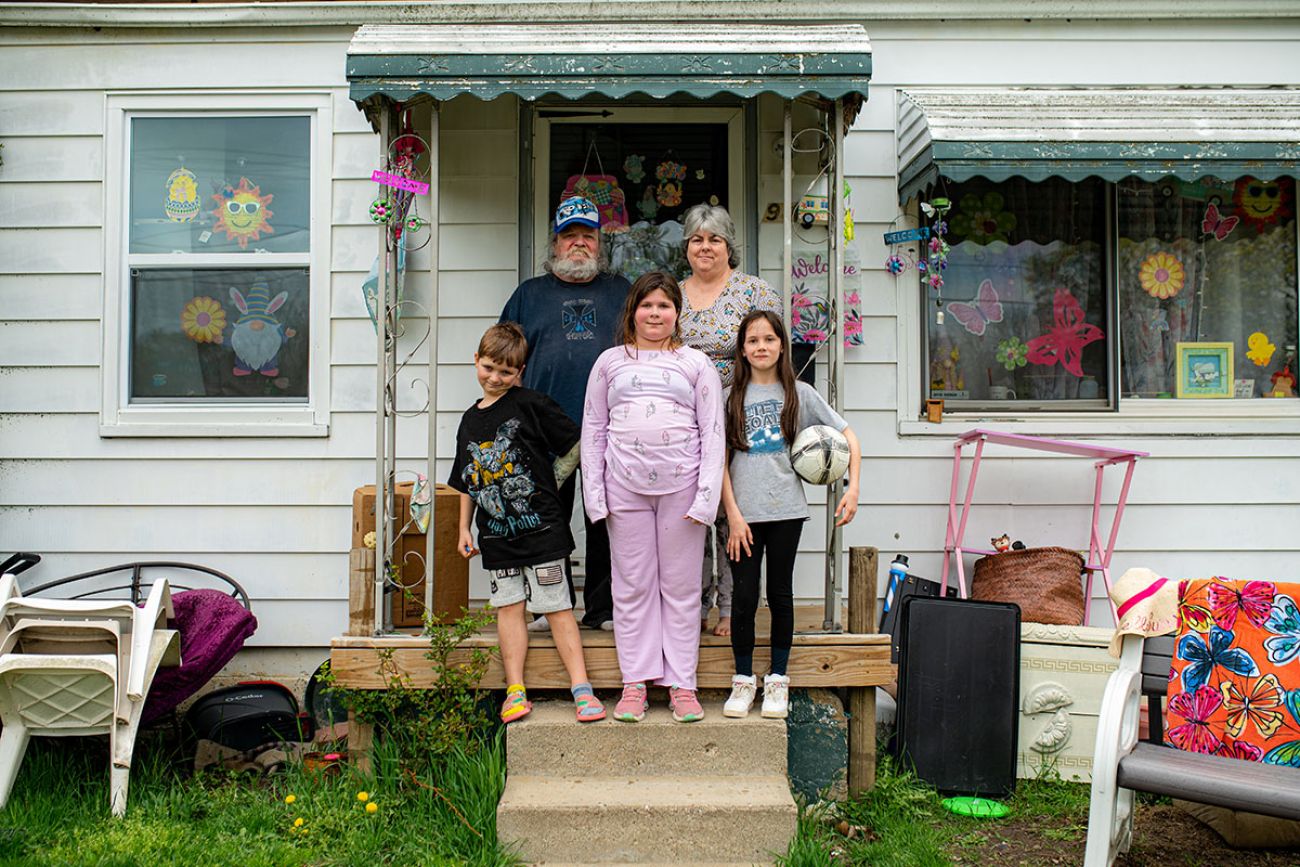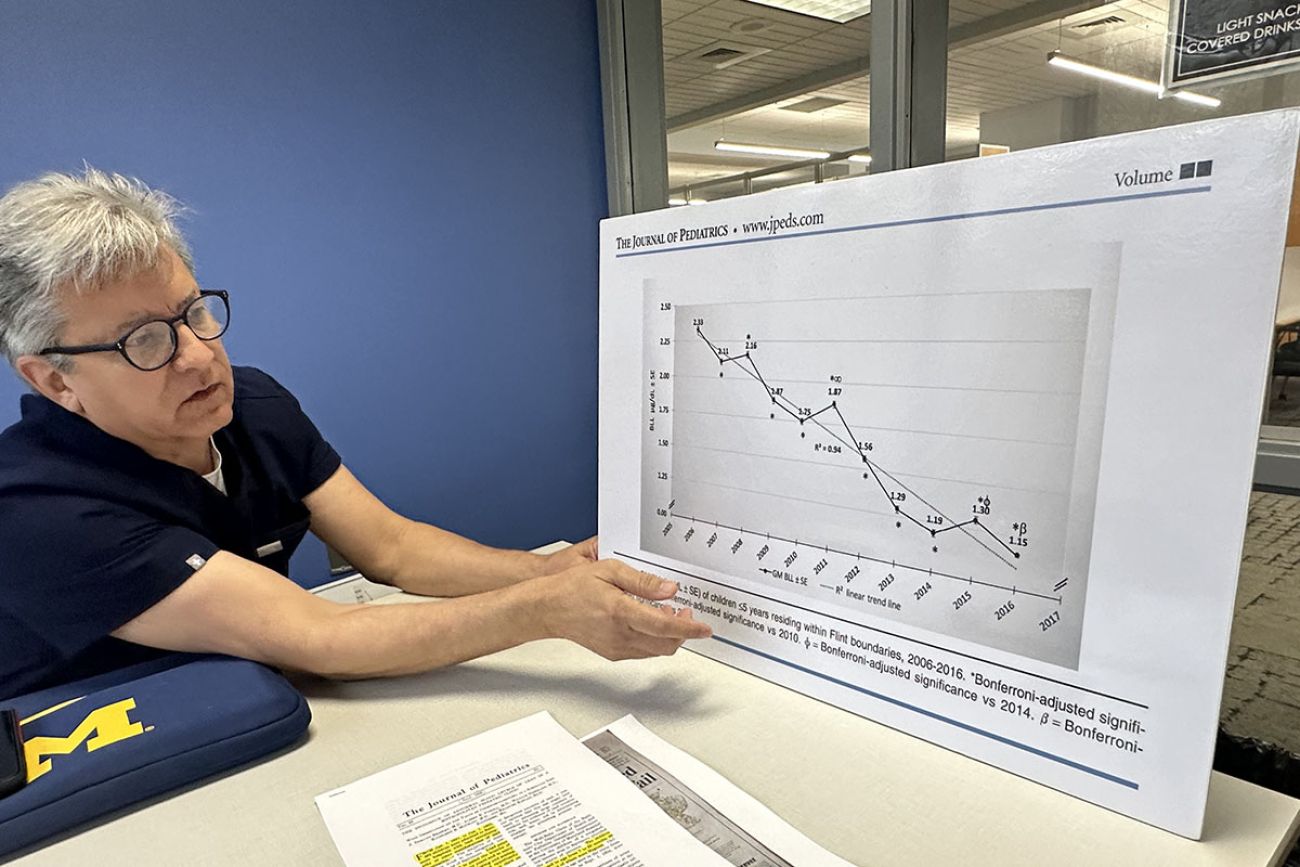Flint water crisis: Did ‘myth’ of lead harm become self-fulfilling prophecy?

- Mistakes with water supply management led to lead leaching into the faucets of Flint residents a decade ago
- Despite dire warnings at the time, recent studies suggest lead didn’t cause long-term damage to children
- Even at the height of the water crisis, lead exposure was lower in Flint than some other Michigan communities
FLINT — Laurie Frost’s 11-year-old grandson was slow to walk and slower to speak. He struggles academically and has been held back a grade.
He and his sister frequently say “that they can’t achieve nothing, you know, because they aren’t good enough,” said their grandmother, Laurie Frost, who is their caretaker.
The kids believe so because they’ve heard all their lives that their exposure to lead as infants would cause them to struggle in school, and Frost has no doubt.
Her grandson was born with fetal alcohol syndrome and has the added hurdles of ADHD, depression and growing up in one of America’s poorest cities. But while blood tests when he was young never found lead at the level the CDC sets for concern, his grandmother said she has no doubt what is holding him back.
“The lead,” she told Bridge, crying.
“I made his formula bottles with the (tap) water. It was before we knew better.”

Marc Edwards shakes his head when told the story of the Frost family. Edwards was a hero of the Flint water crisis for running the first tests proving there was lead in the water supply in Flint homes in 2014 and 2015. Today, the Virginia Tech professor is a pariah in that city for suggesting that predictions of disaster for Flint children were overblown.
To be sure, Edwards said what happened to Flint is an American tragedy borne of government malfeasance. But he and a growing chorus of scientists say that ongoing struggles of children in Flint are not from lead, but the “hyperbolic” reaction to the crisis that has lowered expectations for a generation and become a self-fulfilling prophecy.

Indeed, research shows that only a minority of Flint children were exposed to lead in their homes, and many of those were exposed for less time than the full 18 months the city was using river water, as more families switched to bottled water to avoid the smelly, discolored liquid coming out of their faucets.
Even at the height of the crisis, the percentage of children with troubling levels of lead in their blood in Flint was lower than in some other Michigan communities.
Teachers who spoke with Bridge Michigan disagreed, saying that the children in their classrooms are learning less and acting out more than before the water crisis, and that lead is at least part of the reason.
That debate is critically important to the children of Flint. If their academic, mental health and behavioral struggles are not an irreversible result of lead poisoning, then with additional support they can succeed in school — and life — at levels feared impossible 10 years ago.
“I think we can expect excellence from the children of Flint, and that should be the standard,” said Dr. Hernan Gomez, a toxicologist and pediatric emergency room physician at Hurley Medical Center in Flint. “There is no reason scientifically to view it any other way.”
‘Overblown’ brain damage fears
There were just over 16,000 children aged 10 or younger in Flint when the water crisis began in 2014. That’s when officials switched the water supply from the Great Lakes Water Authority, the Detroit water supplier that provides treated water from Lake Huron to many communities in southeast Michigan, to the Flint River. That uncorked a series of mistakes that culminated with lead from lead pipes leaching through the faucets and showers of homes in some neighborhoods of the blue-collar town.
In September 2015, Edwards and his team from Virginia Tech found “serious levels of lead” in the water supply.
"The levels that we have seen in Flint are some of the worst that I have seen in more than 25 years working in the field," Edwards told Michigan Radio at the time.
By the time the water supply was switched back to safer, properly treated water a month later — 18 months after the fateful switchover — lead was showing up in blood samples of a growing number of children.
At the peak of the crisis in 2014, the percentage of children in Flint who met or exceeded the Centers for Disease Control’s level for concern (5 micrograms per deciliter) was 4.9% — an increase from 2.2% the year prior to the water supply switch. By comparison, the state average in 2014 was 3.5%.
While relatively minor, the increase was alarming because lead rates had been declining for decades in Flint and across the country. Lead can cause permanent damage to bodies. Particularly vulnerable: young children, who scientists, doctors and innumerable headlines warned at the time of the Flint crisis could suffer from diminished learning ability, behavioral problems and mental health issues.
There were dozens of headlines saying the children of Flint had been “poisoned” (including the Bridge Michigan book,“Poison on Tap”). Teachers, the mayor and pediatricians were quoted warning of permanent damage to kids drinking lead-tainted water.
“We have a school district where all that’s left are damaged kids who are being exposed to other damaged kids, and it’s causing more damage,” a Flint teacher told the New York Times in 2019.
Then-Mayor Karen Weaver wrote in 2015 that “This damage to children is irreversible and can cause effects to a child’s IQ, which will result in learning disabilities and the need for special education and mental health services and an increase in the juvenile justice system.”
That fear for their children’s future permeates discussions with parents during medical appointments, said Dr. Mona Hanna-Attisha, who helped expose the crisis in 2015.
“There’s a forever concern for parents: Is my kid going to be brain damaged?” Hanna-Attisha told Bridge recently.
Lost in the headlines was the fact that the share of Flint children with troubling lead levels wasn’t high from a historical perspective, or even at that time in Michigan.
Flint’s leaders, teachers and parents shouldn’t believe that the city’s children will struggle, said Dr. Susan Buchanan, director of the Great Lakes Center for Reproductive and Children’s Environmental Health at the University of Illinois-Chicago.
“There is scientific proof that lead levels even below 1 (microgram per deciliter) have subtle effects on development,” Buchanan said. “(But) the facts show that lead levels in (Flint) children, overall, were 3 to 5 times lower than what was common for people growing up in the ‘70s and ‘80’s.
In 1999, the share of Flint children with high lead blood levels was 37% — 7.6 times higher than during the water crisis, according to data provided to Bridge Michigan by Hurley physician Gomez. His data reveals that the percentage of children with elevated (5 micrograms per deciliter or higher) lead levels in their bloodstream at the height of the water crisis (4.9%) was lower than the rate in Flint just three years before the water crisis began, in 2011 (6.6%).
Those rates convinced Gomez that the water crisis, though shocking and sad, was unlikely to have caused serious brain damage.
“I was practicing in the 1980s when all children had lead blood levels much higher,” Gomez told Bridge, “and I don’t remember us all walking around like brain-dead zombies.”

In August 2015, 56% of the Flint homes tested for lead during the height of the water crisis had lead levels so low that water from taps met the Food and Drug Administration threshold for bottled water, according to tests taken by a team from Virginia Tech led by Edwards.
During the water crisis in 2014 and 2015, just four Flint children out of 7,691 tested with the highest blood levels of lead had measurements of between 25 and 40 micrograms per deciliter. That level has the same recommendations from the Centers for Disease Control as measurements as low as 3.5, including follow-up testing looking for lead sources in homes.
‘I was practicing in the 1980s when all children had lead blood levels much higher, and I don’t remember us all walking around like brain-dead zombies.’ — Dr. Hernan Gomez
By comparison, there were 28 Michigan children during the time period of the water crisis who had blood lead levels of 40 micrograms per deciliter or higher — zero in Flint, and 14 in Detroit.
At the time of the water crisis, numerous communities around the state had higher percentages of their children with elevated lead levels than Flint, according to data from the Michigan Department of Health and Human Services.
In Owosso, just 30 miles east of Flint, 5.3% of children tested high for lead, compared to 4.9% for Flint. Escanaba in the Upper Peninsula had worse numbers, as did Ludington, Oscoda, Albion and Niles.
The Flint ZIP code with the highest percentage of children with elevated lead levels in 2015 was 48503, which includes the city’s downtown, at 5.7%. That same year, there were 13 ZIP codes in Michigan with at least double that figure, including seven in Detroit and three in Grand Rapids.
‘I can honestly see how constantly hearing the negative aspects of Flint and how the lead is supposed to affect you could influence how you learn.’ — Melodie Marsh
In 2022, four Michigan ZIP codes remained more than double the peak Flint lead levels during the water crisis, three in Detroit and one in Kalamazoo.
There was one big difference: Most lead identified in children comes from paint chips, dust and dirt from generations of use of lead products; the Flint water crisis was directly caused by government malfeasance.
The crisis likely would have been even worse if not for the outcry of resident activists and research by scientists including Edwards and Dr. Hanna-Attisha, associate dean for public health at Michigan State University College of Human Medicine in Flint.
“I applaud those who brought attention (to the lead found in the water supply) to authorities,” Gomez said. “There’s no doubt that the lead levels were rising … (and) the community has every right to be outraged.
“Unfortunately, blaming (Flint’s level of) lead for damage to the nervous system is not only not true, it’s harmful. Instead of scaring families, we should be reassuring them.”
Nocebo effect
Several studies reveal that Flint children have struggled since the water crisis. University of Michigan research found that school-age children in Flint suffered significant academic setbacks after the water crisis, falling five months behind in math from their learning rates before lead leached into the drinking supply.
That study followed children from before the water crisis through 2019, and included children who live in Flint who attended the city school district and those who studied at charter schools or surrounding public school districts.
Another study found Flint children were more likely to suffer from depression and anxiety than the national average.
Two teachers at Flint’s Potter Elementary told Bridge that they’ve seen a marked decrease in learning ability and an increase in behavioral problems, particularly among children who were age 0-5 when the crisis began in 2014. Most of those children are now in grades ranging from upper elementary to high school.
“It's been gradually getting worse,” said sixth grade teacher Karen Christian. “When the water crisis first happened, we didn't see so much (change) because we had a lot of the older kids who weren't affected as much. But now, as we've been getting the ones who were (ages) 1,2,3 (during the crisis) and born into it, those are the ones that we're seeing problems.
“We’re trying to teach children to keep their hands to themselves, to stay seated where they're supposed to be, and instead they're up around hitting each other, slapping each other, talking back constantly”
Third grade teacher Bethany Nyswaner added that some students “don't have the mental capacity to learn (at the rate of pre-water crisis students) and they don't have that retention of knowledge.
“Like, you can sit and work on something, and then a few days later, it's not there. They're not retaining information.”
Both teachers believe lead is the reason Flint children are struggling in the classroom, but one finding in the U-M study raises questions about that.
The study found that students who lived in homes with lead water service lines and those in homes with non-lead lines saw similar learning declines, despite an estimate that those living in lead-service homes consumed 4.5 times more lead per day.
Flint pediatrician Hanna-Attisha told Bridge that children living in homes without lead water pipes could have drunk lead-tainted water at friends’ homes and at school. Still, the finding raises the question: If lead is either not the cause or not the sole cause of children’s school struggles, what is happening in Flint?
Virginia Tech’s Edwards calls it the “nocebo effect,” the negative variation on the placebo effect in which patients given sugar pills respond positively as if they had been given real medication.
In the case of Flint, Edwards says, the community has lowered expectations of how well its children will achieve in school. That message, expressed by parents and teachers, is absorbed by the students, who then assume they can’t learn.
More Flint teachers believe their students have been “lead-poisoned” and are now “brain-damaged” than Detroit teachers, even though Detroit has a higher rate of children with elevated blood levels and did so even during the height of the Flint water crisis, according to a study co-authored by Edwards, which is not yet published but shared with Bridge Michigan.
Everett Graham, who grew up in Flint and recently finished his freshman year at Michigan State University, said lowered expectations can influence how much students learn.
“When people are publishing things and going on television saying things about you that are negative, that there’s no hope but we’re rooting for you … these kids are found to have problems,” Graham said. “These kids are not going to succeed at the same level.”

Melodie Marsh, who grew up in Flint and is now a freshman at Howard University in Washington, D.C., agreed. “I can honestly see how constantly hearing the negative aspects of Flint and how the lead is supposed to affect you could influence how you learn.”
If the impact on children either is not or not solely lead, then it’s possible that the children of Flint could succeed in school and life after graduation at a level not predicted 10 years ago.
Recently, Laurie Frost’s grandson came home with his latest report card, filled with S’s for satisfactory progress, a marked improvement and a relief for grandmother Frost. Still, she worries about what she believes could be more lead issues arising later in life.
“I’m not going to be around forever,” said the 60-year old. “My concern is how they’re going to be later on, and if I have to explain to them, your problems are all because of the Flint water issue.”
“There's certainly no debate that the water did something, and it’s unfair,” Gomez said.
“But it's also unfair for parents and children to believe this myth.”
See what new members are saying about why they donated to Bridge Michigan:
- “In order for this information to be accurate and unbiased it must be underwritten by its readers, not by special interests.” - Larry S.
- “Not many other media sources report on the topics Bridge does.” - Susan B.
- “Your journalism is outstanding and rare these days.” - Mark S.
If you want to ensure the future of nonpartisan, nonprofit Michigan journalism, please become a member today. You, too, will be asked why you donated and maybe we'll feature your quote next time!








